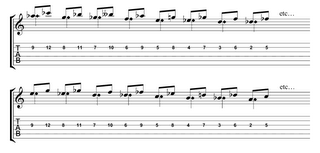playing in position pt. 3: learning the geography
Seems like a long time since my last entry on position playing, and even longer on natural harmonics. So, let me get back to these…
These are the simplest exercises. They’re not, well, even really exercises. These make passable warm ups, but, you know, there are much better stuff you can do for that purpose. Think of these as stepping stones towards playing (and thinking) in position.
If you’ve managed the tasks on playing in position pt. 1: don’t get lost, you should have no problem playing, with the first finger on the fretboard, a chromatic scale (or any other set of intervals for that matter). Find a comfortable point on the guitar (say, around the neck’s mid point), and, just stopping using your first finger, play a descending chromatic scale on the treble E string: Now lets add the other fingers.
Now lets add the other fingers. The position of the first finger is marked in each case with a diamond notehead. Your first finger should remain at this position while fingers two, three and four land on the fingerboard for the upper notes. Relax, don’t use excessive force: you don’t actually need to press down the string with anything other than your fourth finger, but the other fingers should nevertheless rest approximately at the fret positions. The result should be that archetypal ‘finger-per-fret’ shape.
The position of the first finger is marked in each case with a diamond notehead. Your first finger should remain at this position while fingers two, three and four land on the fingerboard for the upper notes. Relax, don’t use excessive force: you don’t actually need to press down the string with anything other than your fourth finger, but the other fingers should nevertheless rest approximately at the fret positions. The result should be that archetypal ‘finger-per-fret’ shape.
This is important: The point of these exercises is to get you used to feeling your location on the fingerboard with that first finger while simultaneously getting comfortable with the distribution of fingers down the frets (the finger-per-fret shape). I reiterate, you should not have to press down hard with all fingers, but at least rest the non-fretting fingers (second and third) gently on the string as the fourth finger comes down.
Stop when it starts to become uncomfortable. As you play these, it is entirely reasonable for you not to go all the way down the neck of the instrument. As you repeat the shape towards the bass end of the instrument’s neck, as the adjacent frets become more distant, you may find that your fingers, hand, arm, etc. become less comfortable. Stop and take a break.
You got the idea? You can now do the same on this on the other strings. And ascending:
And ascending: Once you get this under your belt, try using a metronome, vary the rhythms, articulation and phrasing, add a little swing, etc. Be creative.
Once you get this under your belt, try using a metronome, vary the rhythms, articulation and phrasing, add a little swing, etc. Be creative.
Remember, these are transitory exercises, once onto the next step, you’ll probably never play these again (maybe except to demonstrate to your own students), so don’t dwell on, or over play, these.


No comments:
Post a Comment